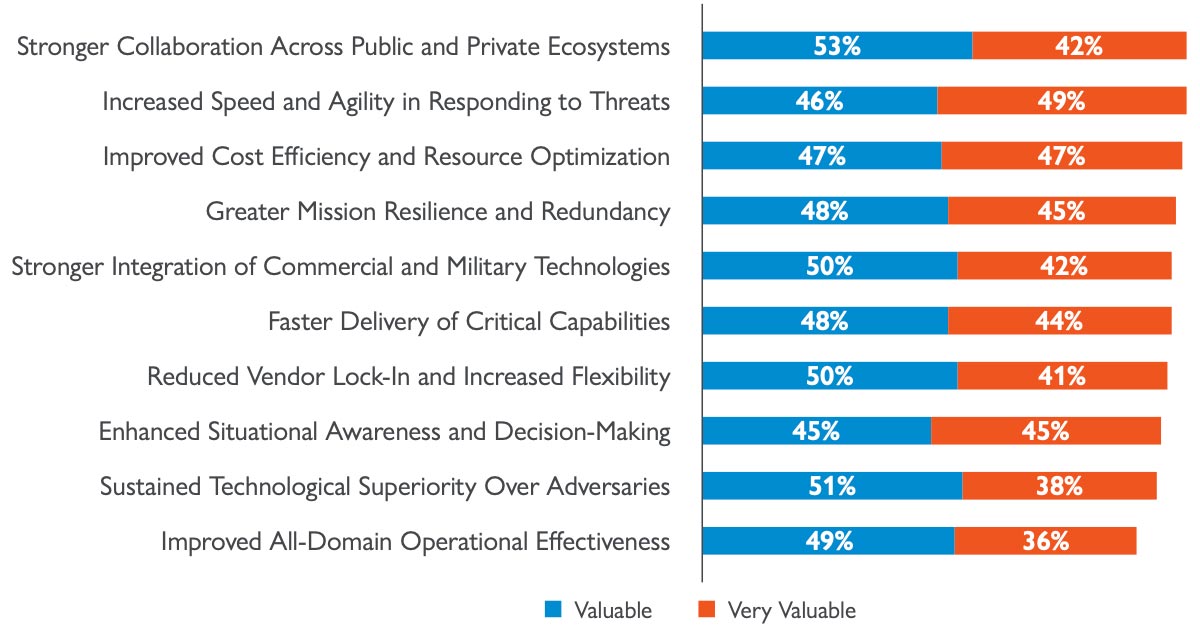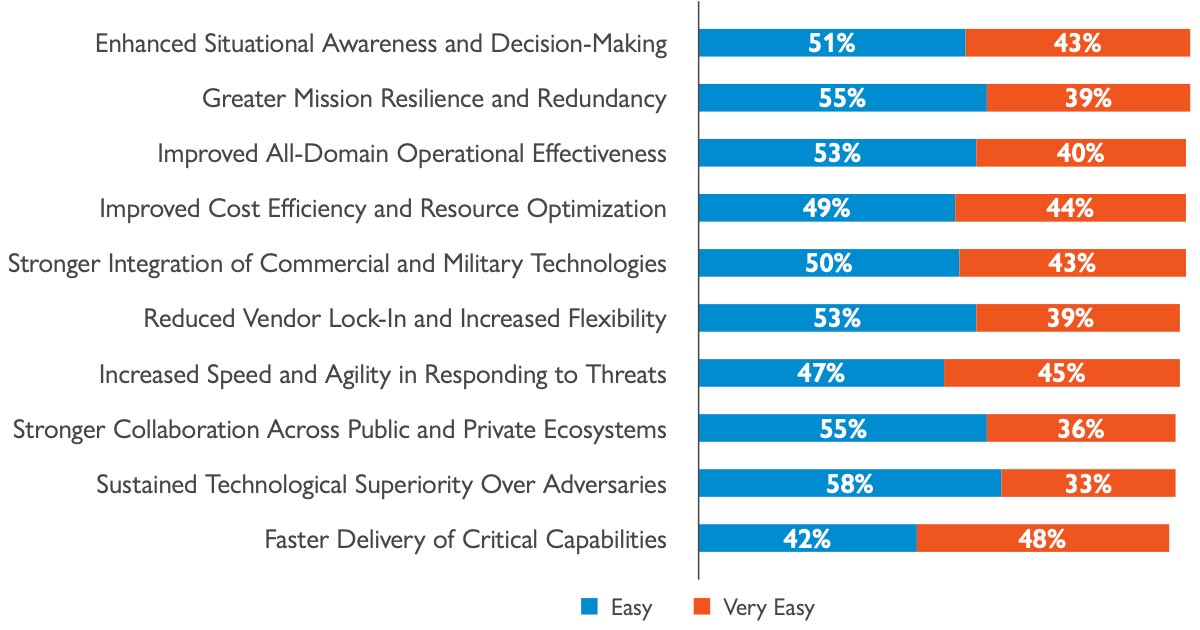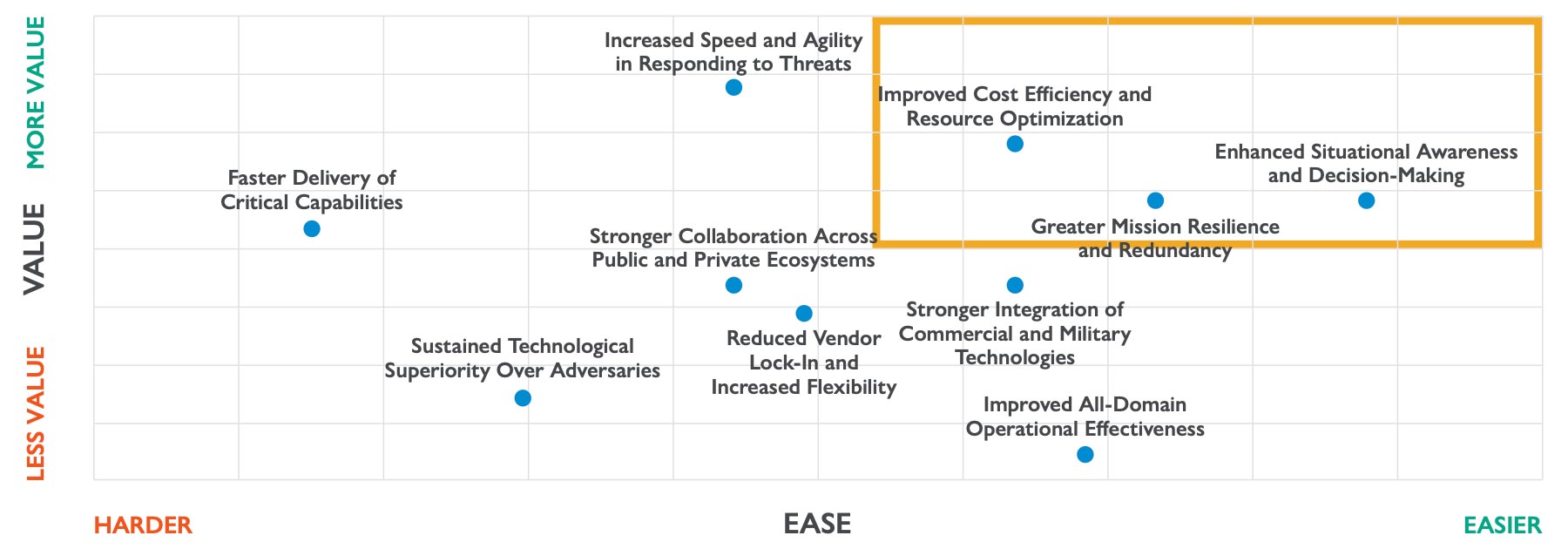Defense and intelligence leaders say that the most valuable outcomes of mission integration are stronger collaboration across public and private ecosystems (95%), increased speed and agility in responding to threats (94%), and improved cost efficiency and resource optimization (93%).
WHAT IS MISSION INTEGRATION?
Mission integration fuses emerging technologies and best-in-class commercial solutions with existing systems to deliver transformative mission outcomes. By leveraging deep mission experience, advanced technology expertise and a collaborative ecosystem of stakeholders, mission integration ensures the security, agility and interoperability of critical capabilities to advance national priorities.
As the technological capabilities and requirements of the U.S. Armed Forces advance, the very nature of modern combat is transforming. Today, assured American military dominance and warfighter adaptability depend not just on cutting-edge technology, but on the ability to integrate it at the speed of conflict. The stakes are clear: to maintain and further our competitive edge over adversaries, our OODA loop must be accelerated. Despite this imperative, data-driven decision-making—a cornerstone of tactical and strategic superiority—is being slowed. This is due to fragmented data, disparate and disconnected hardware and software that, despite their potential, have not been properly integrated with existing technology and systems to achieve mission- critical outcomes with the required speed and scale.
SAIC surveyed 103 respondents from the U.S. Armed Forces to understand the perspectives of federal defense and intelligence leaders on the implementation, challenges, and potential of mission integration.
Eighty-eight percent of U.S. defense and intelligence leaders say that mission integration is a massive or significant contribution to service or agency success. Yet only 35% have achieved it. While leaders acknowledge implementation challenges, they know the key capabilities for operationalizing mission integration.
Defense and Intelligence Leaders Rank Collaboration, Agility, and Efficiency as Most Valuable Mission Integration Outcomes
To understand what mission integration outcomes defense and intelligence leaders consider most valuable, survey respondents rated how valuable each of ten outcomes of mission integration would be in driving the success of their organization and its mission.
Defense and intelligence leaders reported that the five most valuable outcomes of mission integration are (in ranking order): stronger collaboration across public and private ecosystems (95%), increased speed and agility in responding to threats (94%), improved cost efficiency and resource optimization (93%), and greater mission resilience and redundancy as well as stronger integration of commercial and military technologies (both 92%). The top-ranked outcomes in Figure 1 would be most likely to drive the success of their organization and its mission. These findings support the high potential value that defense and intelligence leaders see in mission integration.

Figure 1: Top-Ranked Mission Integration Outcomes
N=103 Defense and Intelligence leaders
Q: How valuable would each of the outcomes of Mission Integration be in driving the success of your organization and its mission? (Please rate each of the following outcomes on a scale of 1 to 5, where 1 = Not at all Valuable and 5 = Very Valuable. If the outcome is not applicable to the mission of your organization, please rate it “NA”)
Figure displays the percentage of respondents who rated each outcome as 4=Valuable or 5 = Very Valuable
Defense and Intelligence Leaders Identify Situational Awareness, Resiliency, and Operational Effectiveness as Easiest to Implement
Respondents also rated how easy it would be for their organization to employ mission integration to achieve each outcome. Results are displayed in Figure 2.
Among the ten outcomes, Defense and Intelligence leaders were most likely to rank enhanced situational awareness and decision-making as well as greater mission resilience and redundancy (both 94%) as the outcomes easiest to implement. These were closely followed by improved all-domain operational effectiveness (93%). These results suggest a readiness and capacity for successful implementation among defense and intelligence leaders.

Figure 2: Outcome Ranked by Ease of Implementation
N=103 Defense and Intelligence leaders
Q13. How easy would it be for your organization to employ Mission Integration to achieve each of these outcomes? (Please rate each of the following outcomes on a scale of 1 to 5, where 1 = Not at all Easy and 5 = Very Easy)
Figure displays the percentage of respondents who rated each outcome as 4 = Easy or 5 = Very Easy
The Quadrants: Mapping Defense and Intelligence Leaders’ Priorities
A quadrant chart (Figure 3) plotting the value and ease rankings from defense and intelligence leaders provides a clear, data-driven framework to view key aspects to achieving mission integration. Mapping key integration activities against both their value to the mission and their ease of implementation, this visual representation enables leaders to identify a clear path forward.
The upper-right quadrant, representing high value and high ease, highlights the initiatives that will deliver the greatest immediate impact and accelerate progress toward full integration. The three outcomes rated as having the greatest value and ease to defense and intelligence leaders were: enhanced situational awareness and decision-making, greater mission resilience and redundancy, and improved cost efficiency and resource optimization. These outcomes are all of critical importance to maintaining military dominance.

Figure 3: A Strategic Framework Mapping Mission Integration Priorities
N=103 Defense and Intelligence leaders
Q12: How valuable would each of the outcomes of Mission Integration in driving the success of your organization and its mission? (Please rate each of the following outcomes on a scale of 1 to 5, where 1 = Not at all Valuable and 5 = Very Valuable. If the outcome is not applicable to the mission of your organization, please rate it “NA”)
Q13. How easy would it be for your organization to employ Mission Integration to achieve each of these outcomes? (Please rate each of the following outcomes on a scale of 1 to 5, where 1 = Not at all Easy and 5 = Very Easy)
“5” values were taken from each question
Utilizing Mission Integration to Achieve Mission-Critical Solutions
Mission integration can play a crucial role in helping US Armed Forces leaders achieve mission-critical solutions. Among the numerous outcomes that successful implementation of mission integration can achieve are:
- Optimizing interoperability of systems and reducing silos
- Prioritizing speed and agility
- Maximizing talent and innovation
- Improving cost efficiency and effectiveness
- Enhancing situational awareness, data-driven decision-making, and mission resilience
The results of the current survey clearly show that defense and intelligence leaders recognize the value of mission integration, and they are considering ease of implementation. Defense and intelligence leaders believe this strategic approach is critical to advancing technological capabilities and innovations while maintaining the nation’s military strength and protecting its critical infrastructure.
Learn how SAIC turns mission integration into mission impact

